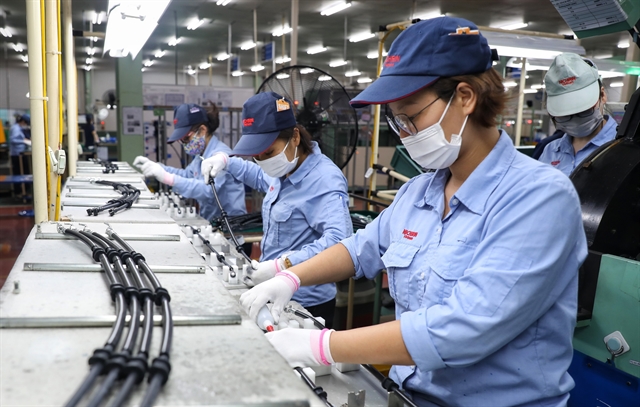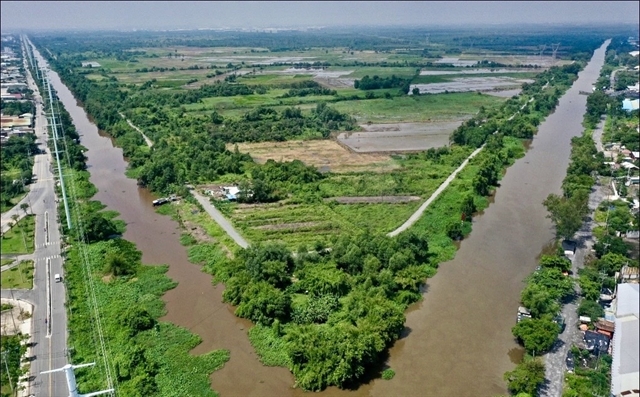 Economy
Economy

 |
| Production at the Japanese-invested Nichirin Vietnam Co. Ltd in the Quang Châu IP, Việt Yên District. Việt Nam's account remained in surplus, driven by resilient FDI and portfolio inflows. — VNA/VNS Photo Danh Lam |
HÀ NỘI — Việt Nam’s real economic growth is expected to slow to 4.7 per cent this year before recovering to 5.5 per cent in 2024 and 6.0 per cent in 2025, according to Việt Nam’s Macro and Poverty Outlook released by the World Bank on Monday.
According to the outlook, after last year’s strong rebound, the economy has been facing domestic and external headwinds in 2023. Weaker global growth and trade have dampened external demand for Vietnamese exports, in turn weighing on growth. Real GDP growth slowed to 3.7 per cent in the first half of 2023, reflecting a slump in external demand and weakening domestic demand, while exports contracted by 12 per cent year on year in the first half of 2023.
Headline inflation fell from 4.9 per cent year on year in January 2023 to 2.1 per cent year on year in July 2023, due to the slowdown of fuel prices and weakening domestic consumption. However, core inflation decelerated at a slower pace, from 5.2 per cent year on year in January to 4.1 per cent year on year in July 2023, partly due to higher costs of construction materials and housing.
Inflation is forecast to average 3.5 per cent this year due to expected civil service salary increases, moderating to 3.0 per cent in 2024 and 2025 assuming stable commodity and energy prices.
Despite external headwinds, Việt Nam’s external position improved in Q1-2023, recording a current account surplus of 1.5 per cent of GDP. The merchandise trade balance improved as imports contracted more sharply than exports, partly due to falling imports of intermediate goods. Meanwhile, the deficit in services trade balance narrowed as international tourists returned. The financial account also remained in surplus, driven by resilient FDI and portfolio inflows.
The surplus in the overall balance of payments has enabled the State Bank of Việt Nam (SBV) to amass foreign exchange reserves, which have now reached an impressive US$88.7 billion as of the conclusion of the first half of 2023.
To address the economic slowdown, the SBV has implemented a loose monetary policy stance. Key policy interest rates were reduced by a total of 150 basis points between March and June 2023. Despite these rate cuts, credit growth remained stagnant at 7.8 per cent in June 2023, primarily due to declining private investment, particularly in the real estate sector. Concurrently, the real estate sector's challenging conditions have led to a deterioration in banks' asset quality, with non-performing loans increasing from 1.9 per cent in December 2022 to 2.9 per cent in March 2023. As a result, the central bank has reintroduced measures to regulate debt repayment term restructuring.
Outlook for 2023
With regard to the outlook for this year, the World Bank said domestic demand is anticipated to be the main growth driver, though it will expand at a slower rate than last year.
The current account is expected to improve further thanks to a modest recovery of exports, continued recovery of international tourism, and resilient remittances.
Despite slower growth, the poverty rate is projected to fall from 3.2 per cent in 2022 to 3.0 per cent in 2023 with the outlook being subject to heightened risks, according to WB experts.
WB experts pointed out that slower-than-expected growth in advanced economies and China could further dampen external demand for Việt Nam’s exports.
Additional monetary policy tightening in major advanced economies could reignite exchange rate pressures on the local currency and lead to capital outflows. Domestically, heightened financial vulnerabilities and risks warrant close monitoring and reforms.
WB economists said that fiscal policy should continue supporting aggregate demand in the short term. They also stressed that a full implementation of the investment budget, supported by steps to ease cumbersome public investment procedures, would bring public investments to 7.1 per cent of GDP in 2023, up from 5.5 per cent in 2022.
In addition, maintaining an accommodating monetary policy is appropriate, but further interest rate cuts would increase the rate differential with global markets, potentially putting pressure on the exchange rate.
To mitigate heightened financial risks, increasing banks' capital buffers and enhancing the banking sector supervisory framework would promote financial sector resilience and stability, they noted.
According to the World Bank’s East Asia and Pacific October 2023 Economic Update, growth in developing East Asia and Pacific is projected to remain strong at 5 per cent in 2023 but will ease in the second half of 2023 and is forecast to be 4.5 per cent during 2024. — VNS




